Fig. 10.1
Liver constitution type
Those who have this liver constitution have a special vitality in their eyes. Their prominent physiological characteristic is rapidity and the ability to adapt quickly.
These subjects usually have a weak liver metabolism and biliary system.
They can develop spastic colitis, constipation, or hemorrhoids. They have a tendency toward muscle hypertonicity that lends itself to the phenomenon of contracture in addition to cramps and spasms. The rapidity in the reactions and the tendency to spasm expose them to possible heart attacks.
In this constitution type, it is suggested that subjects avoid food rich in xenoestrogens and cheese (their lipids worsen liver function), limiting foods that are too rich in iodine or excessively stimulating.
For optimal liver function, an adequate portion of energy deriving from easily assimilated carbohydrates and water content of fruits and vegetables, citric acid, vitamin C, and food rich in potassium can be very helpful.
10.1.2 Human Constitution Type 2: Heart–Adrenal
The distinguishing feature of these individuals is that they have very efficient adrenal gland activity. They can be compared with the blood–Hippocratic type. Fat deposition takes place in the areas most stressed by androgen hormones and cortisol. This form predominantly localizes fat in the upper area of the body (trunk, shoulders, and back of neck area) with barely evident waist line and remarkable development of the muscular system (Fig. 10.2).
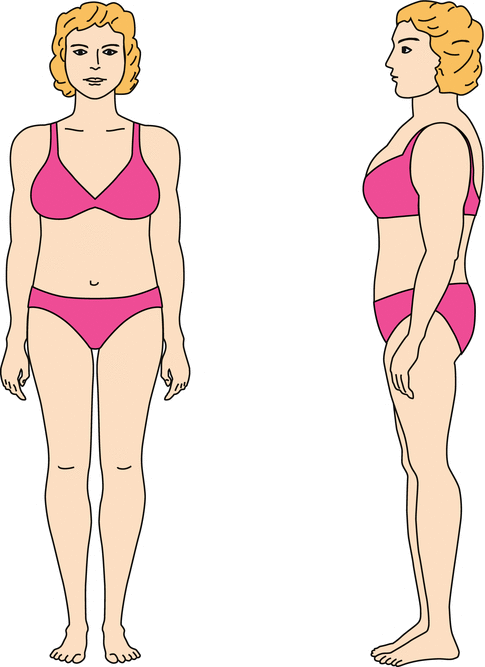

Fig. 10.2
Heart–adrenal constitution type
From the psychological point of view, they are active and efficient, resolved, with good adaptability and capable of assuming positions. They are often persons of power. Areas of vulnerability are represented by cardiovascular disease, high blood pressure, dilated cardiomyopathy, hypercoagulable blood, headache, and facial flushing linked to high blood pressure. This is the constitution type that is most vulnerable to consequences related to excess of salt and oxalate.
The greatest risks for this type are associated with the kidneys and cardiac function, which are subjected to a blood pressure consistently above average, which produces frequent blood hypercoagulability, with the risk of thromboembolic phenomena. Glycemic imbalance or diabetes type II (related to hypercortisolemia) and imbibition tissues can be observed.
It is necessary to include in the diet foods that improve the function of the kidneys and also assist in the elimination of body fluids to counteract the imbibitions caused by increased cortisol.
Individuals with this constitution type must not use foods that promote the synthesis of androgens and the activities of the adrenal glands. They should also avoid anything that impairs the kidney function, such as red meat (which also stimulates the synthesis of androgens) and sometimes gluten. It may be useful to avoid excess minerals and antidiuretic food associations and limit all foods that stimulate anabolism.
10.1.3 Human Constitution Type 3: Pancreas
This type is comparable to the phlegmatic type of Hippocrates. The prevalence of the parasympathetic nervous system slows down overall metabolism easily with the accumulation of visceral fat located mainly around the waist and hips. The weak point is the metabolism of glucose and of insulin and thus the key is to promote their regulation.
The face is round, the mouth and lips are carnose, and the subcutaneous tissue is soft. Therefore, the keywords are: roundness and soft tissues (Fig. 10.3).
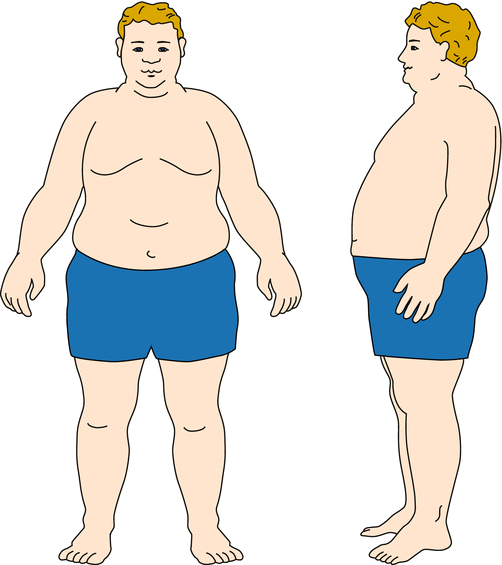

Fig. 10.3
Pancreas constitution type
The appearance of subjects with this constitution type is calm and reassuring. They have great difficulty with adaptation. They show an increased risk for developing type II diabetes or insulin resistance and sometimes hypothyroidism.
As the endocrine and exocrine function of the pancreas often go hand in hand, subjects who belong to this constitution may suffer from digestive disorders: gastralgia, gastritis, ulcers, pancreatitis, hiatal hernia, fatty liver, and colitis, with a prevalence of diarrhea.
For this constitution type, it is more important to choose foods with low glycemic and insulin blood indexes, especially in the evening, and to use protein and fat to slow the peak of postprandial hyperglycemia. It is also recommended to boost the thyroid with iodine-rich foods, limiting the use of milk and derivatives and all foods that have sedative properties. Snacks are to be avoided, and are generally not required if the insulin is balanced.
10.1.4 Human Constitution Type 4: Lung
Classical pictures of the lung constitution type, which is comparable with Hippocrates’s “melancholy” type, show individuals who are thin, pale, and with narrow shoulders.
Dryness and lack of elasticity that affect the skin and respiratory system are the main features (Fig. 10.4).
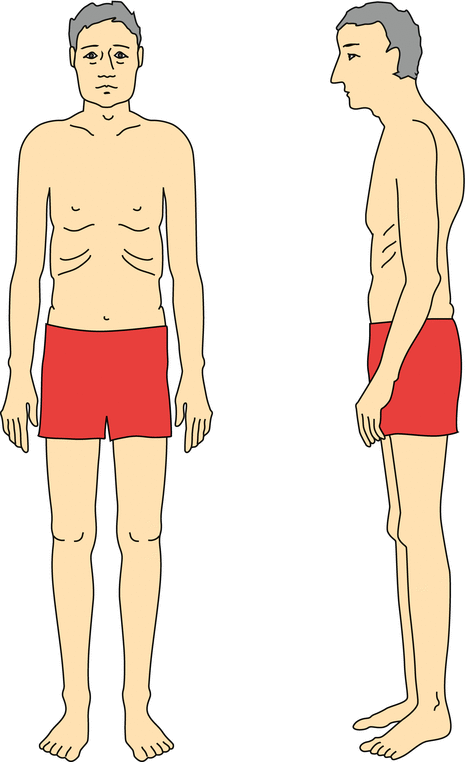

Fig. 10.4
Lung constitution type
This type often has insufficient vital energy, which is counterbalanced by considerable mental capacity.
Psychologically, they tend to reflect more than act. They tend to project their life experiences into the future leading to high levels of apprehension. They have a tendency to fall into pessimism or sadness and seem cold, cynical, and greedy.
They tend to have weak immune systems and are easily affected by bronchitis, pneumonia, laryngitis, chronic rhinitis, sinusitis, and in less favorable cases, asthma, chronic bronchitis, emphysema, and chronic pulmonary heart. They are at risk of thromboembolic events.
A curvature of the spine can be observed with aging leading to a predisposition for osteoporosis that is linked to vitamin D deficiency. In this constitution, the anabolism must be supported. It will be necessary to ensure adequate intake and absorption of iron, calcium, vitamins C and D, and protein of high biological value and carbohydrates.
From a nutritional perspective, lipids are essential in cases of dryness of the pulmonary pleura. They are substantial for the energy function as they compensate for the relative dryness and atrophy of the skin, of mucous membranes, and of all the structures of the respiratory system.
10.1.5 Human Constitution Type 5: Kidney
Not comparable to any Hippocratic type, the kidney constitution type has hypoadrenalism, which affects the body, psychology, and the behavior of a patient. Key signs are physical weakness and poor defenses (they easily get sick). For very thin people, it tends to be more embedded with a typical chillness that the patient often refers to as “cold to the bone” (Fig. 10.5).
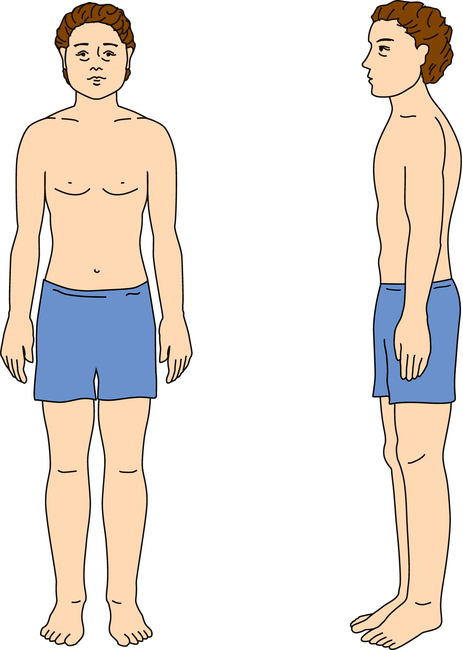

Fig. 10.5
Kidney constitution type
This type is vulnerable from all points of view. They are continuously protecting themselves from attacks that originate outside and are felt internally. Not surprisingly, the basic emotion is fear. As it is a constitution that needs yang, it is usually known to absorb a great deal of energy from the doctor. From the psychobehavioral point of view, the kidney constitution type includes refined people, with a greater mental capacity. They are creative and lovers of beauty and of art in general. Individuals of this constitution type are subject to urogenital infections and kidney-related hypertension. As the kidney carries the essential energy, this type can develop chronic fatigue. Predominantly elderly people have degenerative osteoarticular systems. Nutritional guidelines for people with these characteristics are among the most difficult, because we must overload the kidney’s metabolites, while at the same time managing the trend of the body’s progressive decline of vital energy. Managing bodily fluids should be favored by avoiding antidiuretic foods and moderating the use of meat so as not to create nitrogenous waste. Excessive consumption of plant proteins, especially gluten, should be avoided. Eggs, milk, and dairy products form the best proteins.
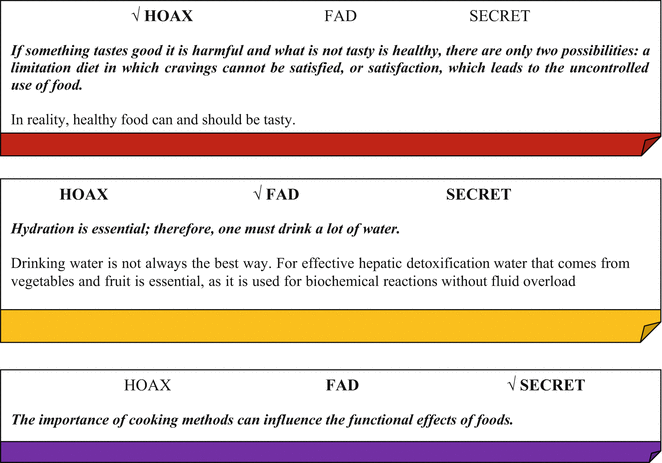

10.2 Energy for the Heart
Choosing supplements and taking them can be an act of love toward oneself.
Diet is the essential starting point, but the correct number of nutrients cannot always be consumed through food. Studies have shown that several nutrients and functional foods play an important role in the prevention and progression of cardiovascular disease.
10.2.1 The Magic Organelle: The Mitochondria
There are many aspects to cardiovascular disease, with the central issues always being the loss of energy efficiency in the heart muscle and the coronary arteries that feed it (Fig. 10.6).
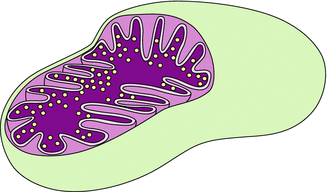

Fig. 10.6
Mitochondria
As the heart and blood vessels are rich with mitochondria, their tissues require a highly effective and efficient use of energy. Natural compounds can modulate mitochondrial functions by inhibiting organelle enzymes or metabolic pathways [3]. They alter the production of mitochondrial ROS and modulate the activity of transcription factors that regulate the expression of mitochondrial proteins. In the future, the importance of supporting energy production in the heart cells and preserving the mitochondria within them will be the focus of cardiovascular disease prevention.
The production of ATP requires coenzyme Q10 (CoQ10) as it is an essential component in the transfer of electrons from chemical bonds in food molecules to chemical bonds in the ATP molecules.
Coenzyme Q10 reduces inflammation, is a potent anti-oxidant, and is the first line of defense against low-density lipoprotein (LDL) oxidation. Statin therapy may lower plasma CoQ10 concentrations [4]. New data have shown that COQ10 as ubiquinol has a direct anti-aging effect as it assists the actions of the SIRT family of proteins that slow senescence through multiple biochemical mechanisms [5]. Significantly reduced cardiovascular mortality was observed in a 10-year follow-up of a group of healthy elderly participants, who were given 4 years of treatment with coenzyme Q10 and selenium.
The protective action continued beyond the intervention period into the follow-up period.
Carnosine has multi-targeted effects and is most prominent in the heart. It improves energy metabolism in the mitochondria, decreases ischemia, and enhances left ventricle function.
This protection derives from the anti-glycation, anti-oxidant, and anti-inflammatory actions of carnosine. It has the capacity to act on insulin resistance, and remove the accumulation of heavy metals and reduce damage to telomeres. A large systematic review published by researchers from the Mayo Clinic demonstrates strong evidence of carnitine’s benefits for heart health [6].
Their publication shows that carnitine supplementation has been associated with a 27% reduction in all-cause mortality, a 65% reduction in ventricular arrhythmias, and a 40% reduction in angina symptoms in patients who have had heart attacks.
d-ribose, a naturally occurring pentose sugar that is a key component in the energy molecule ATP, may support energy generation and functional recovery for patients with ischemic heart disease and diastolic dysfunction [7]. Supplemental d-ribose is an excellent option for preventing and treating cardiovascular disease.
Selenium is essential for the proper functioning of the enzyme systems and heart. A decrease in selenium in the blood leads to decreased glutathione peroxidase activity. This in turn makes the heart tissue more vulnerable to damage, which can weaken its functioning.
A study was published of over 600 coronary artery disease patients in which it was found that the increased risk of cardiovascular events was independently associated with low activity levels of glutathione peroxidase in the red blood cells [8].
Selenium can be used when statins have significantly reduced the synthesis and activity of glutathione peroxidase.
High intake of dietary flavanols and flavones such as quercetin have been associated with a lowering of the risk of cardiovascular disease. In numerous studies, quercetin has been examined and found to be a powerful anti-oxidant and stimulator of nitric oxide and prompts reverse cholesterol transport. Intriguing new research on quercetin has suggested that this protection might be a result of the effects of quercetin on the preservation of mitochondria in the heart and sirtuins [9].
It has been shown that quercetin curbs oxLDL-induced endothelial oxidative injuries through the activation of SIRT1 and regulating the AMPK—NO synthase signaling pathway.
The benefits of resveratrol are well known. At the same time, its clinical efficacy and supplemental benefits in humans are controversial. Trans resveratrol offers various benefits to the cardiovascular system: it lowers the amount of inflammation and oxidation of LDL, supports a decrease in platelet aggregation, and promotes the relaxation of small blood vessels via nitrile oxide [10]. Additionally, resveratrol restricts ROS production in cardiomyocytes via SIRT1 and mitochondrial biogenesis signaling pathways [11].
Curcumin is well known for its anti-inflammatory and anti-oxidant properties. Curcumin has the ability to react directly with ROS and also to induce the expression of cytoprotective and anti-oxidant proteins through the transcription factor Nrf2. Recently, it has been suggested that mitochondrial function and metabolism are associated with Nrf2 and that curcumin activity decreases mitochondrial dysfunction [12].
Pomegranate also has multiple therapeutic functions beyond its anti-oxidant and anti-inflammatory properties, including improving mitochondrial function and increasing nitrile oxide.
Studies have demonstrated that pomegranate and its extracts work to decrease the accumulation of cellular cholesterol, protect LDL against oxidation and have the potential to significantly raise levels of activity of the enzyme paraoxonase-1 (PON-1) in the body, which protects high-density lipoprotein (HDL) from oxidation. These changes take place with an important decline in levels of vascular cell adhesion molecule-1 (VCAM-1), an important endothelial-produced inflammatory protein.
The active component in pomegranate, punicalagin, improves cardiac mitochondrial impairment in an experimental model via AMPK activation [13].
l-Arginine is known to serve as a precursor to nitric oxide in the endothelium.
New insights have been gained through recent data, which shows the role of l-arginine transport in mitochondrial biology and cardiovascular disease [14].
The increase in mitochondrial l-arginine is emerging as a new therapeutic strategy for myocardial disorders involving mitochondrial stress.
Lipoic acid is a unique anti-oxidant molecule that serves as a coenzyme in the energy metabolism of fats, carbohydrates, and proteins. It works at its best when combined with antioxidants, including vitamin E, CoQ10, carnitine, and selenomethionine.
Green tea extracts are abundant in natural anti-oxidant and antiplatelet agents and are commonly used in Asia to reduce high cholesterol and lower blood pressure [15].
Published research has shown that green tea could be beneficial as an anti-oxidant and to the reduction of hyperlipidemia and the incidence of atherosclerosis.
Vitamin C is a strong reducing agent that gives cytoprotection by scavenging ROS and therefore, defending DNA, protein, and lipids against peroxidation.
Vitamin C may have an impact on the bioavailability of nitrile oxide through the direct stimulation of the enzyme responsible for the synthesis of nitrile oxide synthase or tetrahydrobiopterin, an essential cofactor in nitrile oxide synthase activity [16].
Vitamin E is often known to work in conjunction with vitamin C for its potent anti-oxidant powers.
It has also been shown to have many other actions such as to lower lipid peroxidation and inhibit smooth muscle cell proliferation, platelet aggregation, and oxidized LDL uptake.
It acts on cytokine production, reducing blood levels of homocysteine and improving insulin sensitivity [16]. Physiological doses of gamma tocopherol are more effective than alpha tocopherol at enhancing the activity of superoxide dismutase and have more preventative effects on cardiovascular disease.
Vitamin D has protective effects for cardiovascular health that are carried out via several mechanisms. It affects systemic inflammation, insulin resistance, vascular endothelial function, and the hypertensive hormone angiotensin II, and lowers the risk of cardiovascular mortality [17].
Vitamin K2 is now emerging as an exciting long-acting vitamin in the prevention and potential regression of coronary atherosclerotic plaque because of its ability to lower vascular calcification and to help to prevent vascular disease [18]. Vitamin K2 can work together with vitamin D to slow arterial calcification, whereas statins can reduce vitamin K2, resulting in an increased risk for arterial calcification.
Anemia is increasingly recognized as an important factor in heart failure. In a recent study that included the analysis of more than 1,500 heart failure patients, 50% of subjects were found to have an iron deficiency [19].
Profound changes in how the heart, blood vessels, and other tissues function can be effected by moderate magnesium deficiency. It can be used therapeutically for a range of cardiac factors including arrhythmias, hypertension, atherosclerosis, and endothelial dysfunction.
This is a result of the vital role played by magnesium in tissues that have electrical or mechanical activity, such as nerves, muscles (including the heart), and blood vessels. Magnesium is critical to the way our body manages its energy and for maintaining normal metabolic function. It is an essential “cofactor” for more than 300 enzymes, and preliminary research has shown it to be an absolute requirement for maintaining and repairing telomeres [20].
Extra virgin olive oil is a kind of liquid gold. It has been shown to improve many cardiovascular risk factors, such as lipid profiles, blood pressure, postprandial hyperlipidemia, endothelial dysfunction, oxidative stress, and anti-thrombotic profiles.
Stay updated, free articles. Join our Telegram channel

Full access? Get Clinical Tree


